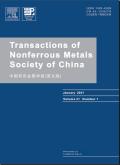烧结温度和保温时间对具有快速离子导电性的 Li1.5Ga0.5Ti1.5(PO4)3 电解质的结构和性能的影响
IF 4.7
1区 材料科学
Q1 METALLURGY & METALLURGICAL ENGINEERING
Transactions of Nonferrous Metals Society of China
Pub Date : 2024-09-01
DOI:10.1016/S1003-6326(24)66588-X
引用次数: 0
摘要
Li1.5Ga0.5Ti1.5(PO4)3(LGTP)被认为是一种很有前途的锂离子固态电解质材料。本研究在不同工艺条件下制备了 LGTP 固态电解质材料,探讨了烧结温度和保温时间对相对密度、相组成、微观结构、体积电导率和总电导率的影响。在频率为 1-106 Hz 的阻抗测试中,样品的体积电导率随烧结温度的升高而增大,总电导率先增大后减小。扫描电镜结果表明,陶瓷的平均晶粒尺寸受烧结温度的控制,当温度从 750 ℃ 变为 950 ℃ 时,平均晶粒尺寸从(0.54±0.01)μm 增加到(1.21±0.01)μm。随着孔隙率的增加,陶瓷的相对密度随温度升高而增加,然后降低。保温时间对晶粒尺寸增长或样品密度影响不大,但延长保温时间会导致裂纹产生,从而降低固体电解质的导电性。本文章由计算机程序翻译,如有差异,请以英文原文为准。
Effect of sintering temperature and holding time on structure and properties of Li1.5Ga0.5Ti1.5(PO4)3 electrolyte with fast ionic conductivity
Li1.5Ga0.5Ti1.5(PO4)3 (LGTP) is recognized as a promising solid electrolyte material for lithium ions. In this work, LGTP solid electrolyte materials were prepared under different process conditions to explore the effects of sintering temperature and holding time on relative density, phase composition, microstructure, bulk conductivity, and total conductivity. In the impedance test under frequency of 1−106 Hz, the bulk conductivity of the samples increased with increasing sintering temperature, and the total conductivity first increased and then decreased. SEM results showed that the average grain size in the ceramics was controlled by the sintering temperature, which increased from (0.54±0.01) μm to (1.21±0.01) μm when the temperature changed from 750 to 950 °C. The relative density of the ceramics increased and then decreased with increasing temperature as the porosity increased. The holding time had little effect on the grain size growth or sample density, but an extended holding time resulted in crack generation that served to reduce the conductivity of the solid electrolyte.
求助全文
通过发布文献求助,成功后即可免费获取论文全文。
去求助
来源期刊
CiteScore
7.40
自引率
17.80%
发文量
8456
审稿时长
3.6 months
期刊介绍:
The Transactions of Nonferrous Metals Society of China (Trans. Nonferrous Met. Soc. China), founded in 1991 and sponsored by The Nonferrous Metals Society of China, is published monthly now and mainly contains reports of original research which reflect the new progresses in the field of nonferrous metals science and technology, including mineral processing, extraction metallurgy, metallic materials and heat treatments, metal working, physical metallurgy, powder metallurgy, with the emphasis on fundamental science. It is the unique preeminent publication in English for scientists, engineers, under/post-graduates on the field of nonferrous metals industry. This journal is covered by many famous abstract/index systems and databases such as SCI Expanded, Ei Compendex Plus, INSPEC, CA, METADEX, AJ and JICST.

 求助内容:
求助内容: 应助结果提醒方式:
应助结果提醒方式:


